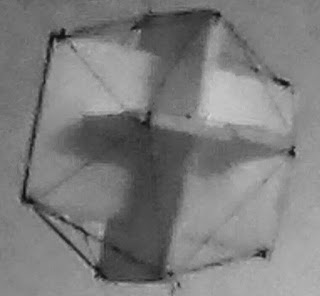Platonic Solids and Logic
When I first learned there are just 5 platonic solids I was surprised and a bit confused. Why 5? 0 or 1 or $\infty$ all seem like reasonable possibilities, but 5 is just so ... arbitrary. And how on earth can you ever be sure there aren't more that just haven't been found yet?
The first proof I saw went like this:
- If 6 equilateral triangles share a vertex the total angle subtended at the vertex is $60^{\circ} \times 6 = 360^{\circ}$ meaning it's flat (they're in a plane). So platonic solids with equilateral triangles must have 3, 4, or 5 trangles sharing each vertex. That's 3 platonic solids!
- If 4 squares share a vertex the total angle subtended at the vertex is $90^{\circ} \times 4 = 360^{\circ}$, and likewise that means it's in a plane. So there can only one platonic solid made from squares, namely one with 3 squares sharing each vertex. One to go!
- Since $108^{\circ} \times 3 < 360^{\circ} < 108^{\circ} \times 4$ the only platonic solid made from pentagons has 3 faces sharing each vertex.
- And since $120^{\circ} \times 3 = 360^{\circ}$ there are no platonic solids made from hexagons (or any other polygons)!
I then saw another very different proof. This time ignore the exact angles and notice that if you stretch one face you end up with a planar graph (a network of vertices and edges that can be drawn on paper without any edges crossing). For planar graphs Euler's formula holds
$$
V - E + F = 2
$$
Where V, E, and F are the number of vertices, edges, and faces respectively. It's easy to see why this is true. Imagine drawing a line between two vertices. Then, $V - E + F = 2 - 1 + 1 = 2$ so the formula holds. But you can build up any planar graph by steps in which you either split a line by placing a vertex, or split a face by connecting two vertices with an edge. In the former case both $V$ and $E$ go up by one; in the latter both $E$ and $F$ go up by one. Either way $V - E + F$ remains the same.
Now, in the case of platonic solids we can add a couple of extra equations
$$
n F = 2 E \\
d V = 2 E
$$
where $n$ is the number of edges per face, and $d$ is degree of each vertex (the number of edges connected to each). Dividing Euler's formula by $E$ gives
$$
\frac{2}{d} - 1 + \frac{2}{n} = \frac{2}{E}
$$
which implies
$$
\frac{1}{d} + \frac{1}{n} > \frac{1}{2}
$$
This gives the same results:
- if $n = 3$ then $d$ must be 3, 4, or 5
- if $n = 4$ then $d$ must be 3
- if $n = 5$ then $d$ must be 3
- if $n >= 6$ then no value of $d$ works (you cannot have a degree of 2)
But, for me, the strangeness that there are only 5 platonic solids has been replaced with another, even stranger, strangeness. Why is it that some things true for more than one reason? Proofs are like acyclic graphs. The axioms are at the base and you hop along edges to get to the theorem. It seems to me that if you have two such proofs it ought to be possible to somehow show that they are the same, like there's just one underlying reason for a thing to be true, and that the multitude of different proofs are really just obfuscations of the one from the book. But that doesn't seem to be true and I just can't quite get my head around it.




Comments
Post a Comment